WealthScapes 2013 Reveals Rising Fortunes Among Canadians
For the first time, the average household net worth of Canadians has topped $400,000, according to the WealthScapes 2013 financial database released today by Environics Analytics. The average household net worth figure of $400,151 as of December 31, 2012, represents a 5.8 percent increase over December 31, 2011. The data continue to show that the average Canadian household is richer than the average American household—by $19,066 (with the dollar at par), or 5.0 percent, this year—though that gap narrowed considerably over the past year.
The data on Canadian net worth (the total combined value of liquid and real estate assets minus debt) is one of several upbeat findings in WealthScapes 2013, now in its sixth year reporting household financial statistics. Although many Canadians still face higher-than-normal unemployment, the latest statistics reveal just how far the recovery has come since the 2008 economic downturn. Nationwide, the new data indicate that stock portfolios are growing, the value of real estate is increasing and household debt has ticked up only modestly. “The financial crisis is now well in Canada’s rear-view mirror,” says Peter Miron, a senior research associate at Environics Analytics and lead developer of WealthScapes 2013. “Everything appears to be on the upswing.”
Created by Environics Analytics (EA), a Toronto-based marketing services and data analytics company, WealthScapes helps companies like financial institutions and retailers as well as charitable organizations analyze the fiscal health of current and potential customers, identify promising markets and develop business strategies to increase their market share. Updated to December 31, 2012, the 2013 release has been expanded to include 109 financial and investment statistics, providing additional income classes, financial ratios and investments categorized by both segregated and mutual funds. And as in years past, the database was built using sophisticated modelling techniques and a variety of authoritative sources—such as the Bank of Canada and Statistics Canada—to create the most reliable financial data available in the industry.
Among the other noteworthy findings coming out of the WealthScapes 2013 release:
Major Cities
1. Vancouver, Calgary and Toronto Still the Wealthiest Three of Canada’s largest cities retained their bragging rights as the wealthiest in Canada: Vancouver, with its pricey real estate—$551,461 per household—continues its reign as the city with the highest net worth: $662,600 per household. Calgary, with the most debt of any major city—$198,589—ranks second in net worth, with $620,607 per household. And Toronto, with $617,846 in net worth, maintained its third-place ranking. Canada’s most populous city benefitted from a 5.0 percent decline in consumer (non-mortgage) debt, the largest drop of any major city, and a healthy 6.3 percent rise in savings per household.
But what’s striking about Canada’s three wealthiest cities is how close they are in terms of their household net worth—all within 7.2 percent of each other. And households in Toronto closed the wealth gap with Calgary to only $2,761. What distinguishes these three cities from others in Canada is the high value of their real estate: The average household in these three cities has about a half-million dollars’ worth of real estate holdings.
2. Regina Roars Ahead There were some surprises among the cities that experienced the greatest increase in net worth during the last year. Regina’s net worth jumped 11.2 percent to $391,826 during 2012, fueled by the strongest growth in real estate holdings among cities—a 10.6 percent increase to $317,029—and the third fastest rise in liquid assets, 10.3 percent to $206,416, behind Saskatoon and Halifax. And in the Golden Horseshoe, Hamilton experienced the second fastest growth in net worth among major cities, up 9.5 percent to $420,515. Its rise was due to strong 9.1 percent growth in household real estate countered by only a modest 2.2 percent rise in household debt. Toronto itself reported the third highest growth in net worth among big cities, increasing 9.4 percent, as a result of three factors: a gain in liquid assets (up 7.7 percent), strong real estate growth (up 8.2 percent) and low debt growth (only 2.9 percent).
“It takes a lot for the largest city in the country to rapidly increase in net worth, so that’s big news for Toronto,” says Miron. “And Hamilton is experiencing a renaissance. It used to be a tough steel town but it is increasingly becoming known as a city of cafes and art galleries.”
3. Montreal and Ottawa Deemed Just Average Two of Canada’s largest cities failed to make the wealthiest list for different reasons. Montreal’s net worth grew at a slightly below-average 4.7 percent (to $315,957) mostly because of households taking on more debt—increasing 5.8 percent to $96,465—while liquid assets and real estate values both grew at average levels. In Ottawa-Gatineau, net worth grew at a slightly above-average level of 6.0 percent, to $393,556. This rise in wealth was driven by a low 1.0 percent rise in debt, to $129,009, but tempered by a below-average increase in liquid assets of 3.1 percent to $199,329. Nevertheless, both cities stand close to national averages in terms of their financial fortunes.
4. Debt Hampers Quebec City’s Recovery With an average household net worth of $250,058, Quebec City traditionally ranks as the least affluent of Canada’s ten largest cities. And 2012 saw no change in that status. Net worth grew at a below-average 4.6 percent, as Quebec City experienced the largest rise in household debt of any major city—7.6 percent to $80,830—while household savings declined 2.3 percent to $58,169.
Provinces
5. The Rich Remain Rich The three wealthiest provinces at the end of 2011 retained their ranking at the end of 2012: 1) British Columbia (net worth: $550,554), 2) Alberta ($484,613) and 3) Ontario ($464,693). Yet the new financial data indicates shifting fortunes among the provinces. Third-ranked Ontario had a good year—its net worth grew by 8.2 percent—and its residents are closing in on Alberta in terms of net worth. Indeed, B.C. and Alberta generally experienced below-average growth in their net worth over the last year, only 2.8 percent and 4.6 percent, respectively.
6. Ontario Reins in Debt One reason behind Ontario’s highest rise in net worth is its slow-growing debt levels. Between the end of 2011 and 2012, Ontario's household debt grew only 2.1 percent to $132,876—the lowest rate of all provinces. Although it’s unclear whether Ontario residents are becoming more cautious or have simply maxed out their credit cards, borrowers are now able to pay down their debt faster than in the past. Perhaps more importantly, this modest increase in debt was the net effect of an average increase in mortgage debt, up 4.9 percent, and the only provincial-level decrease in consumer (non-mortgage) debt, down 3.6 percent. As the effective interest rate on mortgages is less than half that of consumer debt, Ontario's households are paying less interest than in prior years, which permits further debt repayment and consumption.
7. The New Golden Prairie Province Saskatchewan exhibited the second largest growth in net worth, after Ontario—an increase of 7.6 percent to $351,865. With the province’s abundance of natural resources fueling the economy, Saskatchewan residents increased their liquid assets by 7.4 percent to $208,444, and their real estate holdings similarly grew by 7.7 percent to $243,858. Not even a 7.4 percent growth in debt to $100,437 could dampen the province’s booming performance. “Saskatchewan looks a lot like Alberta a decade ago,” observes Miron. “Residents are complaining about traffic jams. And radio hosts are offering deep breathing tips to motorists whose commutes have increased from eight minutes to a half-hour. It’s the new golden prairie province.”
8. Playing the Market Pays Off With its province-leading 7.7 percent growth in liquid assets—now averaging $144,381—Nova Scotia performed better than in recent years thanks to its rise in stock holdings. Residents tended to invest more aggressively in stocks and mutual funds compared to other provinces and, when the stock market climbs as it did in 2012, so did Nova Scotians’ fortunes. The value of their investment fund and stock portfolios rose at a double-digit rate, 11.0 percent, to $98,326.
Nation
9. A Perfect Storm of Prosperity The 5.8 percent rise in Canadians’ net worth isn’t the result of a single overarching factor. The $400,151 figure represents a strong 5.4 percent increase in liquid assets and a 5.1 percent increase in real estate, along with a relatively modest 3.3 percent rise in debt. Much of the growth in liquid assets can be attributed to the robust stock market: Between the end of 2011 and 2012, the average household saw the value of their stocks rise 5.6 percent and investment funds increase 8.9 percent. Canadian investors benefitted from the rebound in the U.S. economy and financial markets and, despite the continuing euro crisis, improving economic news from Europe. “Last year was marked by a small but noticeable global economic recovery,” says Miron, “with the U.S. recovery starting to take hold at the end of 2012.”
10. More Good Debt and Less Bad Debt Digging into the household debt data reveals some positive real estate and consumer news. Mortgage debt rose at a much higher rate, 4.1 percent, than consumer debt, up only 1.4 percent. The mortgage debt increase reflects rising property values—household real estate holdings rose 5.1 percent—meaning new homeowners needed to take out a larger mortgage to purchase a home. But with lower effective interest rates on mortgages averaging 3.7 percent, consumers were able to purchase more house with a smaller monthly payment. At the same time, consumers racked up less credit card debt. One theory holds that Canadians, increasingly aware of the high interest rates on credit card balances, are turning to alternative forms of payment such as debit cards.
For all the dire warnings that they are overextending themselves as they buy houses, acquire cars and take on more debt, Canadians may actually be getting their fiscal house in order. The average Canadian household is still richer than the average American household ($400,151 CDN versus $381,086 USD, as measured in their respective currencies)—though the difference between the two countries is now about half what it was last year. Compared to the U.S., Canadian households can claim twice as much in real estate ($309,881 CDN versus $152,401 USD) and more in assets ($520,266 CDN versus $481,357 USD) and bank deposits ($82,349 CDN versus $66,811 USD).
Yet Canadians should be careful not to feel too self-satisfied. In the last year, while U.S. household debt declined 2.4 percent, from $102,715 USD to $100,272 USD, Canadian household debt rose 3.3 percent, from $116,309 CDN to $120,115 CDN. Americans may have learned a lesson from their formerly debt-averse neighbours to the north.
Map Gallery (Click to view full-sized map)
Calgary
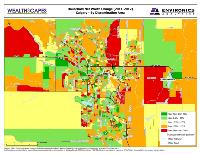
As Canada’s second wealthiest major city, Calgary saw household net worth continue to increase in 2012, with overall growth of 7.1% compared to the Canadian average of 5.8%. Averaging $620,607 per household, net worth saw its strongest growth within the northwestern and southern regions of the city, while neighbourhoods to the north and east saw their average household net worth decline.
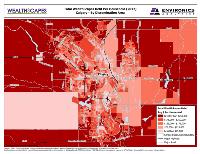
Calgarians carry some of the highest household debt loads among Canadian households. While the average for the Calgary region sits at $198,589, households in the northwestern and southern suburban communities tend to carry even higher debt loads well into the $200,000 range. These households might take comfort in the fact that while their debts are among Canada’s highest, Calgary actually saw below-average increases in household debt loads in 2012 – up 3.1% from 2011, compared to a national increase of 3.3%
Edmonton
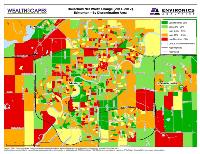
Between 2011 and 2012 Edmonton experienced only a small increase in net worth, up 1.6% to an average of $433,970. Gains in net worth are apparent in pockets throughout the city; the communities west of the university area, the industrial areas in the north east and south along Calgary Trail, as well as the communities of St Albert and parts of Strathcona saw the greatest improvements.
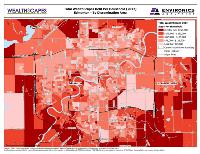
Edmonton increased its debt load from 2011 to 2012 by an average of 2.2% to $155,758 per household. The highest debt loads are generally held by those living in the neighbourhoods near the ring road, south of the Yellowhead; the majority of city centre households have less than $175,000 dollars worth of debt.
Montréal
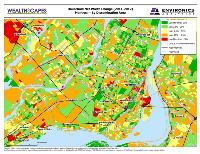
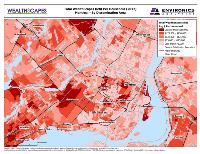
Montréal households carry one of the lowest debt levels of any major city in Canada – $96,465 – with those in Longueull and Montréal-Est typically carrying less than $75,000. The suburban areas of Kirkland and Brossard have some of the highest debt levels in Montreal – often exceeding $175,000.
Toronto
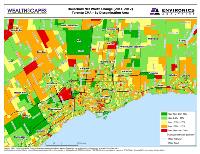
Greater Toronto placed third among major metropolitan areas in Canada, growing by 9.4% in 2012 to an average net worth of $617,846. Parts of Oakville, King City and Brampton saw higher increases in net worth, while neighbourhoods in northwest Toronto and The Beach District in the south fared well in Canada’s largest city. Lawrence Park and Rosedale were among the wealthier areas reporting the sharpest declines last year.
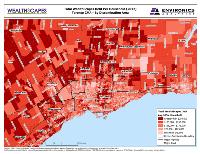
Many Toronto-area households hold debts above $250,000, including those in the affluent Midtown neighbourhoods including Rosedale, Forest Hill, and the Bridle Path as well as neighbourhoods in High Park and The Beach. In Etobicoke, neighbourhoods south of Eglinton Avenue tend to have higher debt levels than the North, while the inverse is true for Toronto’s East end; with communities in Scarborough holding slightly higher debt in areas closer to Markham.
Vancouver
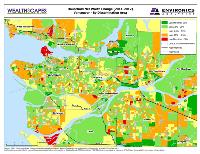
Vancouver continues to have the highest net worth of any major city in Canada, with more than $662,000 per household. Growth remained steady at 4.7% between 2011 and 2012; however, lagged behind other major markets like Toronto and Calgary. The Vancouver landscape did not see concentrated growth, rather a mix of strong gains and mild loss in net worth throughout the communities surrounding the downtown core.
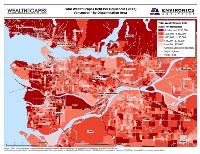
While Vancouver still holds the heaviest debt loads in Canada, between 2011 and 2012 the rate at which debt grew sits just above average when compared to other urban centres. Communities like North Vancouver, West Vancouver and the suburban neighbourhoods of Surrey are all holding more than $175,000 per household in debt, with Richmond and East Vancouver having slightly lower average household debt.


